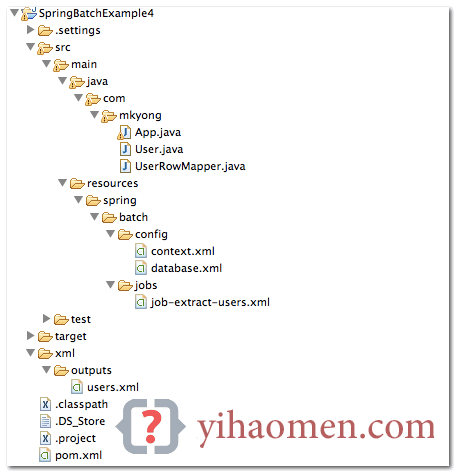Spring Batch Example – MySQL Database To XML
In this tutorial, we will show you how to read data from a MySQL database, with JdbcCursorItemReader and JdbcPagingItemReader, and write it into an XML file.
Tools and libraries used
Maven 3
Eclipse 4.2
JDK 1.6
Spring Core 3.2.2.RELEASE
Spring OXM 3.2.2.RELEASE
Spring Batch 2.2.0.RELEASE
MySQL Java Driver 5.1.25
P.S This example – MySQL jdbc (reader) – XML (writer).
1. Project Directory Structure
Review the final project structure, a standard Maven project.

2. Database
A “users” table, contains 5 records only, later read it with jdbc.
users table
id, user_login, password, age '1','mkyong','password','30' '2','user_a','password','25' '3','user_b','password','10' '4','user_c','password','25' '5','user_d','password','40'
3. Item Reader
Create a row mapper to map database values to “user” object.
User.java
package com.mkyong;
public class User {
int id;
String username;
String password;
int age;
//... getter and setter methodsUserRowMapper.java
package com.mkyong;
import java.sql.ResultSet;
import java.sql.SQLException;
import org.springframework.jdbc.core.RowMapper;
public class UserRowMapper implements RowMapper<User> {
@Override
public User mapRow(ResultSet rs, int rowNum) throws SQLException {
User user = new User();
user.setId(rs.getInt("id"));
user.setUsername(rs.getString("user_login"));
user.setPassword(rs.getString("user_pass"));
user.setAge(rs.getInt("age"));
return user;Example to read data from database.
job.xml
<bean id="itemReader" class="org.springframework.batch.item.database.JdbcCursorItemReader" scope="step"> <property name="dataSource" ref="dataSource" /> <property name="sql" value="select ID, USER_LOGIN, USER_PASS, AGE from USERS" /> <property name="rowMapper"> <bean class="com.mkyong.UserRowMapper" /> </property> </bean>
For big records, you can use JdbcPagingItemReader.
job.xml
<bean id="pagingItemReader"
class="org.springframework.batch.item.database.JdbcPagingItemReader"
scope="step">
<property name="dataSource" ref="dataSource" />
<property name="queryProvider">
<bean
class="org.springframework.batch.item.database.support.SqlPagingQueryProviderFactoryBean">
<property name="dataSource" ref="dataSource" />
<property name="selectClause" value="select id, user_login, user_pass, age" />
<property name="fromClause" value="from users" />
<property name="whereClause" value="where user_login=:name" />
<property name="sortKey" value="id" />
</bean>
</property>
<property name="parameterValues">
<map>
<entry key="name" value="#{jobParameters['name']}" />
</map>
</property>
<property name="pageSize" value="10" />
<property name="rowMapper">
<bean class="com.mkyong.UserRowMapper" />
</property>
</bean>4. Item Writer
Write data to an XML file.
job.xml
<bean id="itemWriter" class="org.springframework.batch.item.xml.StaxEventItemWriter"> <property name="resource" value="file:xml/outputs/users.xml" /> <property name="marshaller" ref="userUnmarshaller" /> <property name="rootTagName" value="users" /> </bean> <bean id="userUnmarshaller" class="org.springframework.oxm.xstream.XStreamMarshaller"> <property name="aliases"> <util:map id="aliases"> <entry key="user" value="com.mkyong.User" /> </util:map> </property> </bean>
5. Spring Batch Jobs
A job to read data from MySQL and write it XML file.
resources/spring/batch/jobs/job-extract-users.xml
<?xml version="1.0" encoding="UTF-8"?>
<beans xmlns="http://www.springframework.org/schema/beans"
xmlns:batch="http://www.springframework.org/schema/batch"
xmlns:xsi="http://www.w3.org/2001/XMLSchema-instance"
xsi:schemaLocation="http://www.springframework.org/schema/batch
http://www.springframework.org/schema/batch/spring-batch-2.2.xsd
http://www.springframework.org/schema/beans
http://www.springframework.org/schema/beans/spring-beans-3.2.xsd
">
<import resource="../config/context.xml" />
<import resource="../config/database.xml" />
<bean id="itemReader"
class="org.springframework.batch.item.database.JdbcCursorItemReader"
scope="step">
<property name="dataSource" ref="dataSource" />
<property name="sql"
value="select ID, USER_LOGIN, USER_PASS, AGE from USERS where age > #{jobParameters['age']}" />
<property name="rowMapper">
<bean class="com.mkyong.UserRowMapper" />
</property>
</bean>
<job id="testJob" xmlns="http://www.springframework.org/schema/batch">
<step id="step1">
<tasklet>
<chunk reader="pagingItemReader" writer="itemWriter"
commit-interval="1" />
</tasklet>
</step>
</job>
<bean id="itemWriter" class="org.springframework.batch.item.xml.StaxEventItemWriter">
<property name="resource" value="file:xml/outputs/users.xml" />
<property name="marshaller" ref="userUnmarshaller" />
<property name="rootTagName" value="users" />
</bean>
<bean id="userUnmarshaller" class="org.springframework.oxm.xstream.XStreamMarshaller">
<property name="aliases">
<util:map id="aliases">
<entry key="user" value="com.mkyong.User" />
</util:map>
</property>
</bean>
</beans>resources/spring/batch/config/database.xml
<beans xmlns="http://www.springframework.org/schema/beans" xmlns:jdbc="http://www.springframework.org/schema/jdbc" xmlns:xsi="http://www.w3.org/2001/XMLSchema-instance" xsi:schemaLocation="http://www.springframework.org/schema/beans http://www.springframework.org/schema/beans/spring-beans-3.2.xsd http://www.springframework.org/schema/jdbc http://www.springframework.org/schema/jdbc/spring-jdbc-3.2.xsd"> <!-- connect to database --> <bean id="dataSource" class="org.springframework.jdbc.datasource.DriverManagerDataSource"> <property name="driverClassName" value="com.mysql.jdbc.Driver" /> <property name="url" value="jdbc:mysql://localhost:3306/test" /> <property name="username" value="root" /> <property name="password" value="" /> </bean> <bean id="transactionManager" class="org.springframework.batch.support.transaction.ResourcelessTransactionManager" /> </beans>
6. Run It
Create a Java class and run the batch job.
App.java
package com.mkyong;
import org.springframework.batch.core.Job;
import org.springframework.batch.core.JobExecution;
import org.springframework.batch.core.JobParameters;
import org.springframework.batch.core.JobParametersBuilder;
import org.springframework.batch.core.launch.JobLauncher;
import org.springframework.context.ApplicationContext;
import org.springframework.context.support.ClassPathXmlApplicationContext;
public class App {
public static void main(String[] args) {
App obj = new App();
obj.run();
private void run() {
String[] springConfig = { "spring/batch/jobs/job-extract-users.xml" };
ApplicationContext context = new ClassPathXmlApplicationContext(springConfig);
JobLauncher jobLauncher = (JobLauncher) context.getBean("jobLauncher");
Job job = (Job) context.getBean("testJob");
try {
JobParameters param = new JobParametersBuilder().addString("age", "20").toJobParameters();
JobExecution execution = jobLauncher.run(job, param);
System.out.println("Exit Status : " + execution.getStatus());
System.out.println("Exit Status : " + execution.getAllFailureExceptions());
} catch (Exception e) {
e.printStackTrace();
System.out.println("Done");Output. Extracts all “user where age > 20” into an XML file.
xml/outputs/users.xml
<?xml version="1.0" encoding="UTF-8"?> <users> <user> <id>1</id> <username>mkyong</username> <password>password</password> <age>30</age> </user> <user> <id>2</id> <username>user_a</username> <password>password</password> <age>25</age> </user> <user> <id>4</id> <username>user_c</username> <password>password</password> <age>25</age> </user> <user> <id>5</id> <username>user_d</username> <password>password</password> <age>40</age> </user> </users>
References









